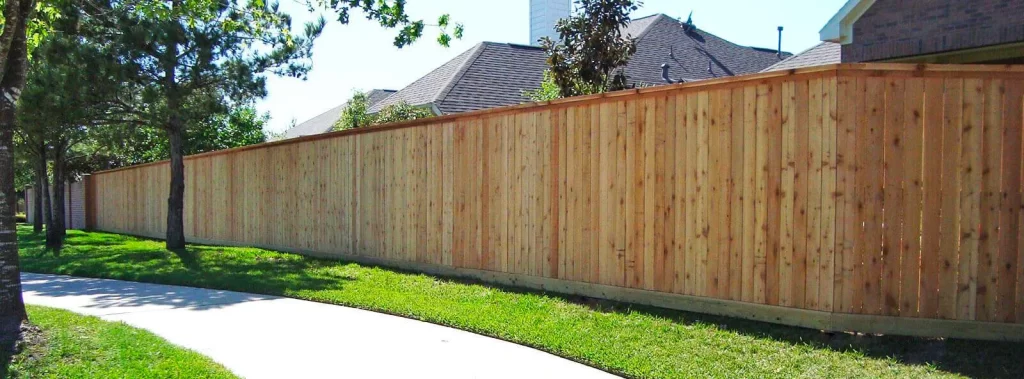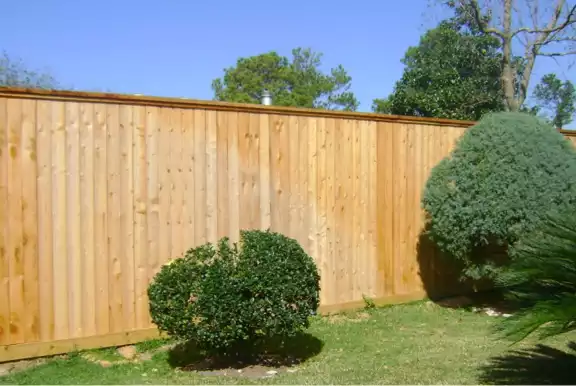Wood Privacy Fences

Wood Privacy Fences – The Best Way to Enhance Your Home’s Security
Privacy is a valuable commodity these days. Whether you’re in a big city or a rural retreat, having an indoor sanctuary is more important than ever.
Security technology can provide extra layers of protection, but it’s hard to beat the traditional wooden fence for boosting your home’s security.
Wood privacy fences have been a go-to choice for homeowners for centuries and with good reason. With their intimidating height, wide planks, and sturdy construction, a wood privacy fence is the ultimate shield against pesky intruders. But the advantages of a wood privacy fence don’t end there.
In addition to providing complete privacy and security, wood fences come in a wide variety of colors and styles, allowing you to customize your home’s curb appeal and add an extra layer of charm to your outdoor space. In this blog post, we’ll explore why wood privacy fences are the best way to enhance your home’s security and offer some tips for choosing the perfect fence for your home. Let’s start with the basics.
Benefits of Installing a Wood Privacy Fence
Installing a wood privacy fence not only increases the security of your home, it also boosts the aesthetic value of your property. From cedar to tropical hardwoods and standard construction-grade woods, wood fences come in many durable varieties that can be stained or painted to match any color scheme. Plus, the more traditional materials make for a timeless look that can quickly become a focal point on any property. The cost of installing a wood privacy fence is slightly less than other fencing options, like vinyl or aluminum. In some cases, if you build it yourself with basic materials and tools, you may even be able to save some money by using reclaimed lumber.
When considering installing a wood privacy fence, one drawback is the amount of maintenance this type of fencing requires. Wooden fences need regular upkeep such as staining or painting every few years, changing rotted boards or posts and repairing damaged sections due to weathering, pests or vandalism. If these tasks are neglected or not done properly, a wooden fence can look old and worn out within a few years. Overall, there are many advantages to installing a wood privacy fence – from stylish looks to an affordable price tag, these fences are sure to add charm to your outdoor space while making it more secure.
Types of Wood and Hardware for Fencing
When selecting a wood privacy fence for your home, it is important to consider the type of wood and hardware necessary for the installation. A variety of woods can be used for fencing such as cedar, redwood, oak, and pine. Cedar is the most popular choice because of its natural resistance to decay and moisture absorption. Redwood is also a popular option due to its sturdiness and aesthetic appeal. Oak and pine are less common choices since they are more brittle than other materials and may require more maintenance over time. Each type of wood has its own advantages and disadvantages.
Cedar is usually the most expensive option, though it does come with a natural resistance to pests and moisture; however, its life span might not match that of some of the other woods. Redwood is strong but requires frequent maintenance. Oak and pine have weaker damp-resistant qualities, thus increasing the likelihood that they will need to be replaced sooner rather than later due to accelerated rot or insect damage. In addition to choosing the right type of wood for your fence, you’ll also need to select the appropriate hardware such as nails, screws, bolts, hinges, latches, and post caps. It’s important to know the type of metal being used in each piece of hardware so that you can ensure its durability.
Furthermore, if there are any specialty pieces needed for your fence installation (e.g., gate handles), you want to make sure these pieces are made from materials able to withstand severe weather conditions such sun exposure or windy conditions. Overall, there is no one-size-fits-all solution when it comes to selecting materials for building a wood privacy fence since each homeowner needs their own personal style mix of strength, longevity and aesthetics. While both sides must be weighted carefully before making a final decision about which type of wood and hardware would work best for you, taking into account all factors – such as budget considerations – can help narrow down your options.
● A study conducted in 2018 found that installing a wood privacy fence around a home increased perceived safety, property value, and quality of life.
● According to the same study, residents with wood privacy fences reported higher levels of perceived length of residence than those without fences.
● An additional survey published in 2021 indicated that homes with wooden privacy fences have an average 8% increase in their resale value compared to those without them.
Installation Process for a Wood Privacy Fence
Installing a wood privacy fence is a major project that requires careful planning, consideration for local zoning codes, and a few tools. Depending on the direction one goes in, the installation process can range from DIY to professional, and require varying degrees of resources. For those who are experienced in this type of construction and feel comfortable building their own wood fence there are tutorials available online as well as detailed instruction manuals that provide step-by-step instructions outlining how to develop a wooden privacy fence. However, it’s important to note that these tasks can be time consuming and labor intensive. Furthermore, if something isn’t done properly it risks compromising the integrity of the fence which could create potential safety hazards down the line. As such, it’s prudent to make sure you have an understanding of fencing structures before attempting this task.
At the other end of the spectrum is hiring a professional team of installers who specialize in installing wood fences. This option is typically more expensive when compared to DIY but there are advantages; doing so ensures that the job is completed quickly, safely, and with all necessary documentation in order – such as permits, or paperwork required by your local government jurisdiction. While pros might cost more upfront, they often eliminate many headaches associated with attempting this project yourself. Regardless of what path you choose however, there are several steps involved in properly installing a wood privacy fence that must be followed regardless.

Considerations for Privacy Fence Designs
When it comes to choosing a privacy fence design, there are several considerations to keep in mind. First and foremost is the security aspect of the design. A high-quality, stable material should be used for the fence and gate to ensure it won’t fall apart easily. The height of the fence should also be taken into account; a fence that is too low won’t provide much privacy or security, while one that is too high might make your property appear overly restrictive or fortress-like. Another consideration is appearance – wood fences come in a variety of styles that can add charm and character to any home exterior. You may opt for classic picket fencing, or traditional solid wood panels.
Consider whether you would like a decorative detailing such as lattice and trim or fancy scrollwork, which could add an extra layer of interest. Vinyl fencing can achieve a similar effect with even less maintenance, but some homeowners prefer the classic look of real wood. Privacy fencing can also be customized with color treatments such as staining, sealing and painting to complement existing home colors, stone accents, hardscaping and landscape features. In terms of cost effectiveness and longevity, however, labor-intensive treatments such as lining panels with special stains must be weighed against simple coatings of easy-to-apply sealer oils.
The bulk and positioning of your chosen fence should also be taken into account when deciding on a design. Do you want a slight barrier around only part of your yard or do you need something more substantial that spans an entire lot? These are important questions to answer up front when selecting a style to minimize future headaches down the road due to incorrect measurements or placement choices. No matter what kind of privacy fence design you choose, it’s important to get professional help if you’re unsure about how to go about constructing it. When done properly, wood privacy fences offer excellent protection against intruders while providing extra curb appeal and charm.
Cost and Maintenance of a Wood Privacy Fence
When evaluating the cost and maintenance of a wood privacy fence, it is important for homeowners to understand the pros and cons so they can make an informed decision. While installing a wooden privacy fence can be more expensive in comparison to other fencing options, there are many benefits that might make it worth the investment. In addition to providing extra security and privacy for a home, a wooden fence is fairly low-maintenance and can last for many years with proper care. The initial cost of installing a wood fence will depend on the type of wood chosen, size of the space, complexity of the design, and other factors. For instance, cedar boards tend to be more costly than lower grade woods like pine or pressure-treated lumber. Also, having a custom design may require additional carpentry work which could also add to the overall cost. However, if done properly and invested in high quality materials, a wooden privacy fence can be expected to last 15 to 20 years with regular maintenance.
On average, the maintenance costs associated with a wood privacy fence will vary depending on the climate where it is installed. An area exposed to strong winds or lots of moisture will require more frequent stain or paint touch ups than one in a dryer environment. Unprotected boards tend to fade from harsh UV rays over time so opting for water proofed stains or sealers are recommended for longevity. On average then, yearly maintenance costs will likely be around $200-$300 per year although that could go up for larger areas or more extensive tasks such as replacing broken boards. Overall, wood privacy fences are a great option for many homeowners because of their aesthetics and various customization options available. With regular maintenance and upkeep however, these types of fences can provide peace-of-mind security as well as added value to a home’s resale value for many years down the road.
Common Questions
How much does it typically cost to install a wood privacy fence?
The cost of installing a wood privacy fence typically ranges from $3,000 to $15,000, depending on the size and complexity of the project. The costs will depend on many factors like the type of wood used, local labor costs and availability of materials, site conditions, and the number of posts and panels needed for the installation. Other extra costs may include permits and fees, depending on the local regulations in your area. The best way to get an accurate estimate is to contact a qualified licensed fencing contractor who will be able to provide you with a detailed quote after conducting an onsite visit and evaluating the project requirements.
What are the best maintenance and care practices for wood privacy fences?
The best maintenance and care practices for wood privacy fences depend on the type of fence that has been installed, however, some general guidelines can help to ensure your fence maintains its strength, beauty and longevity. First and foremost, it is important to inspect the fence for damage. Make sure to check the posts and rails for signs of decay or damage from animals or weather conditions. If any such damage is found, make sure to address it as leaving it unattended could lead to major deterioration. Secondly, keep the fence clean by removing debris like leaves or twigs. A pressure washer can be used at least once a year—in combination with a cleaning solution formulated specifically for wood—to rid the wood of dirt and debris buildup. Finally, regular staining and sealing should be done every few years depending on the climate (being sure to use products designed specifically for exterior wood.) This helps to protect the fence from moisture and ultra-violet rays. Staining and sealing also enhances the look of your fence, which adds beauty and value to your home.
What are the advantages and disadvantages of using different types of wood for a privacy fence?
Advantages of using different types of wood for a privacy fence: 1. Different woods offer a variety of colors, textures, and grain patterns which can add beauty to a home’s exterior. 2. Natural wood has been the most popular choice for residential fences due to its timeless character and affordability. 3. Certain woods such as cedar, redwood, and cypress are more rot-resistant due to their cellular structure and natural oils. This makes them better for outdoor use than other wood species. Disadvantages of using different types of wood for a privacy fence: 1. Some woods can be susceptible to moisture damage or rotting over time if not treated and maintained. 2. The cost can vary depending on the type and quality of lumber used, meaning it may not always be the most option. 3. Some treated woods can contain hazardous chemicals that can leach into the ground over time, creating potential safety risks to you, your family, and the environment.








